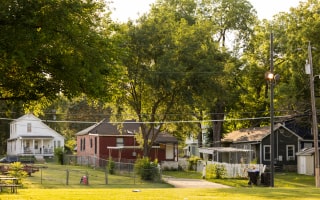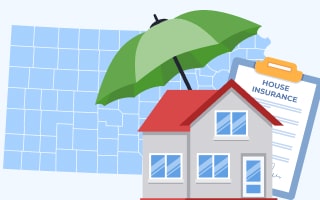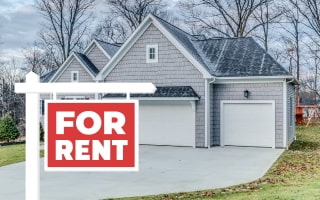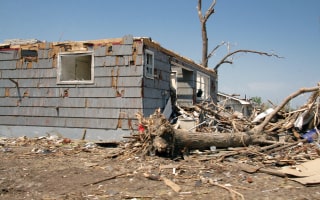Homeowners Insurance in Kansas

If you are a fan of The Wizard of Oz, you'll remember that Kansas takes center stage as an area where deadly tornadoes rule. In addition to dangerous and costly tornadoes, Kansas residents are also subject to earthquakes, wildfires, and violent storms in winter and summer. Since 1953, Kansas has had 70 federally declared disasters (higher than many states), and the disaster rate per 1 million people is 23.77.
Although many insurance claims in Kansas come from damaging weather, others are due to frozen/burst pipes, vandalism, theft, liability, heavy snow, trees falling, and ice.
Although states don't require homeowners insurance, experts always suggest that everyone who owns a home have at least some type of protection. If you take out a loan to buy a house in Kansas, your lender will require that you carry home insurance for the life of the loan, and they will dictate the coverage limits.
The national average for homeowners insurance is $2,511/year. In Kansas, residents pay an average of $4,435/year, which is well above the national average.
Types of Homeowner Insurance Coverage Available in Kansas
Regardless of where you live, you have a certain number of insurance providers to choose from and various types of coverage available to you. Only certain carriers will operate in some states with a high risk of natural disasters. The most common types of insurance you can buy in Kansas are:
-
Dwelling: Dwelling coverage pays to repair or rebuild your home after a qualifying event. It covers the structure of your home, such as the walls, roof, foundation, etc.
-
Other Structures: Other structures coverage will pay to replace detached items like a pool, garage, shed, or fence.
-
Personal Property: Personal property coverage pays to replace your belongings if they are destroyed or stolen.
-
Liability: Liability insurance pays your legal bills if someone gets hurt on your property and then sues you.
-
Medical Payments: If someone is injured on your property due to your negligence, this insurance will pay their medical bills.
-
Additional Living Expenses (ALE): If you are forced to vacate your home while it is repaired or rebuilt, ALE insurance will pay for your expenses (food, lodging, travel, etc.).
Kansas is a high-risk state, so you may not be able to obtain other types of coverage, such as flood, hurricane, or umbrella policies.
FEMA (Federal Emergency Management Agency) manages the National Flood Insurance Program (NFIP) through a network of 50 providers across the U.S.
Since most homeowners insurance does not cover floods, this supplemental coverage can repair damage and replace items after a flood. It can cover the building and/or your personal belongings, depending on your chosen options. This program is available to homeowners, renters, and businesses. Learn more about the program on FEMA's website.
Home Insurance and Natural Disasters
Global warming has far-reaching effects, including more frequent natural disasters that damage property and risk lives. Climate change is the main reason that insurance rates are rising, and providers are pulling out of specific markets. Over the past five years, home insurance rates have increased by 34% and even as high as 60% in some areas. From 2018 to 2023, home insurance rates in Kansas increased by 27.3%.
Unfortunately, Kansas is a high-risk state with frequent tornadoes, making it difficult for some homeowners to obtain or keep insurance. Kansas was among the top five states with hail events in 2023, with 459 hail events that year. Also, in 2023, 39 tornadoes destroyed homes and property. In 2022, 67 wildfires destroyed 84,015 acres of land. From 1980 to 2024, Kansas had 98 billion-dollar disasters. Wind and hail claims cost insurers an average of $11,695, and wildfires cost them $77,340 per incident. From 2015 to 2019, Kansas home insurance providers incurred total losses of $544,881,800.
How Can I Save on Homeowner Insurance Premiums in Kansas?
In states like Kansas, home insurance is a costly expense, and homeowners strive to find ways to save. Some of the key issues that impact home insurance costs are:
-
Location: The location of your home matters tremendously. If you live in an area prone to disastrous weather or high crime, you will pay more.
-
Size & Condition of the Home: Size and condition also come into play. The larger your home, the more you will pay. If the house is well-maintained, you will pay less than if it is in disrepair.
-
Age of the Home: The newer the home, the lower your premiums will be.
-
Level of Coverage: The more coverage you purchase, the higher your premiums.
-
Deductible: The larger the deductible, the lower the rates. Balance as high a deductible as possible with the coverage you need.
-
Your Credit Score: People with good credit scores earn lower rates than those with poor credit.
-
Claims History: If you have a lot of claims, even small ones, you will pay more as the insurer will see you as a high risk.
-
Additional Risks: If you have fireplaces, pools, or a hot tub, you will pay more for these "attractive nuisances".
To save money on your home insurance if you live in Kansas, try these tips:
- Reinforce Your Home: Install storm shutters, shatterproof glass, and a stronger, more wind-resistant roof to protect your home against tornadoes and other storms. If you do, you may save on your premiums.
- Get Rid of Risks: Remove risks that add to your insurance costs. Some things that raise rates are swing sets, swimming pools, fireplaces, and trampolines.
- Raise Your Deductible: Increase your deductible to lower your rates.
- Boost Your Credit: Raise your credit score and ask your insurer to re-evaluate your rates.
- Bundle Policies: Bundle all your policies with the same insurance provider and get a discount.
- Ask for Other Discounts: Ask your provider about any other discounts you might qualify for and make changes to apply them.
Home Insurance Discounts in Kansas
Home insurance protects your property against disasters. If, for example, your house burns down in a fire, your insurance policy will pay to rebuild it back to its most current condition. Some qualifying events for home insurance include fire, falling trees, vandalism, theft, smoke, lightning, wind, and hail damage. Most policies include dwelling coverage, personal property, liability, medical payments, other structures, and ALE coverage. However, all policies have coverage limits, so not everything may be covered unless you carry extra insurance, such as an umbrella policy.
You can apply for home insurance in various ways, such as visiting a local insurance agent, calling the company's 800 number, or applying online. You can even find calculators online that help you decide how much coverage you need and the estimated cost. Once you select your provider and coverage, you must pay the first year in advance. After that, you can pay through your mortgage escrow or once a year if you don't have a mortgage.
Some of the most common discounts offered by home insurance carriers include:
- Senior Discount: Many carriers offer discounts to senior citizens.
- Claims-Free Discount: If you go several years without any claims, you might qualify for a discount.
- Safety Discounts: Installing security or safety equipment could help you qualify for a discount.
- Multi-Policy Discounts: If you bundle all your policies with the same insurer, they might offer you a discount.
- New Home or Customer Discount: If you build a new home or are a first-time customer, you might also save money on your rates.
- Military Discount: A member of the military or veteran usually gets a break on insurance rates.
- Payment/Paperless Discount: Sign up for auto payments or paperless statements to get money off your rates.
Common Rates Offer by Homeowners Insurance Firms
When you build a new home, you will pay less for your home insurance. In some places, your savings could be as much as 40% less than the average rate. However, your actual rates will depend heavily on your credit score, coverage limits, deductible, and other factors.
Kansas residents pay an average of $3,570/year or $298/month for new home insurance, which is far less than the average for other homeowners in the state.
Top 10 Home Insurance Firms in Kansas and Average New Home Savings
| Company | % savings |
|---|---|
| Nationwide | 76% |
| State Farm | 51% |
| Allstate | 47% |
| Travelers | 63% |
| USAA | 54% |
| American Family Insurance | 55% |
| Auto-Owners Insurance | N/A |
| Liberty Mutual | N/A |
| Chubb | N/A |
| Amica | N/A |
Home Insurance and Renovations in Kansas

Home renovations beautify and update your home with fresh new styles, colors, and designs, making it more comfortable and valuable. However, these updates can also dramatically impact your home insurance. Some renovations increase your home insurance rates, and others decrease them. Some have a null effect by increasing the value but also lowering risk.
![]() Home Renovations that Increase Rates
Home Renovations that Increase Rates
Some home renovations that increase your rates include:
- Building an Extension: Building an extension, whether for a home office or just to add space, may feel invigorating, but it will increase your home insurance expense.
- Hot Tub or Trampoline: A hot tub or trampoline adds spice to life but will also increase your rates as "attractive nuisances" because they add danger and risk.
- Building a Treehouse: Your kids may be clamoring for you to build them a treehouse, but remember, your rates will go up if you do.
![]() Home Renovations that Decrease Rates
Home Renovations that Decrease Rates
Some home renovations that decrease your rates include:
- Smart Technology: Smart technology that can monitor your home for dangers and risks and send alerts, even calling the fire department or police automatically, could save you money on your home insurance.
- Hurricane Shutters/Straps/Ties: When you upgrade your home to better withstand storms, especially in places like Kansas, you could save big on your home insurance.
- Upgraded Windows: Installing storm windows that are wind-resistant and shatterproof will help you avoid claims and save you money on your insurance.
Some upgrades like siding or solar panels may increase the value and lower the risk; therefore, the costs could cancel each other out.
Remember that homeowners insurance does not pay for regular maintenance and home repairs you choose to make. You must cover those yourself. Your insurer will pay out only for damage due to a covered peril. If you have any questions, contact your insurance agent before doing any work.
You should always contact your insurer before making any major upgrades. Find out how it will impact your coverage and rates. After completing the work, they may want to do a walkthrough to reevaluate.
Kansas Renters' Insurance

Kansas renters home insurance is for people who rent homes like apartments, condos, and houses. It differs drastically from homeowners insurance in that it includes no dwelling coverage. If your home burns down, it will not pay to rebuild it. That must be covered under the owner's policy. Renters insurance mainly covers your personal belongings up to a specific limit you choose. It also includes liability, medical payments, and loss of use.
Some events covered by renters insurance are:
-
Fire
-
Explosions
-
Smoke Damage
-
Lightning
-
Windstorms
-
Broken Pipes/Water Damage
-
Vandalism
-
Theft
Personal belongings such as clothing, furniture, small appliances, sporting equipment, and electronics will be replaced after a qualifying event. However, expensive items may not be covered; check your limits.
Renters insurance is priced based on three main factors:
-
Location: Renters insurance is more expensive if you live in a high-crime area or one prone to natural disasters.
-
Coverage Limits: The more coverage you have, the higher your premiums will be.
-
Number of Units: The more units in your building, the lower your premiums.
The average renter in Kansas pays about $20/month or $236/year, which is still fairly affordable but more than other states. That price includes $40,000 of personal property coverage, $100,000 in liability coverage, and a $1,000 deductible.
Condo Insurance in Kansas

Kansas Condo insurance is homeowners coverage for condo owners. Typical condo associations carry a master policy that covers the structure of the building and will rebuild it should a covered event occur (fire, windstorm, theft). However, this policy will only restore the building back to its original condition, meaning any updates the condo owners have made will not be paid for. Therefore, every condo owner needs condo insurance to pay for those upgrades.
Condo insurance includes dwelling coverage that only covers the condo's interior, picking up where the master policy leaves off. Some things that it will pay to replace are:
- Interior Walls
- Wiring
- Plumbing
- Fixtures
- Appliances
- Flooring
- Cabinets
- Countertops
Condo insurance also includes liability, medical payments, personal property, and loss of use coverage. It does not cover floods, and since it has limits, expensive items may not be covered.
The difference between condo insurance and renters is that condo insurance includes some dwelling coverage (wall-in only), and liability only pays if the person is hurt inside the condo, not on common grounds.
The average rate for condo insurance in Kansas is $40/month or $475/year for $60,000 of personal property coverage and $300,000 of liability with a $1,000 deductible.
Even though condo insurance is pretty affordable, owners still look for ways to save. Some tips are:
- Shop Around/Ask for Recommendations
- Raise Your Deductible
- Bundle Your Policies
- Install Security/Safety Devices
- Improve Your Credit
- Sign Up for Auto Payments or Paperless Billing
- Ask for Discounts
Kansas Home Insurance Market
Despite the high risk of tornadoes and multiple billion-dollar events, the home insurance market in Kansas remains healthy. Insurance providers within the state have been profitable yearly for the past ten years, which cannot be said for all the surrounding states. However, the increase in tumultuous weather threatens that track record, and eventually, insurers will start to see more claims and losses, limiting coverage and reducing competition.
The most significant factors affecting claims and payouts in Kansas are tornadoes and windstorms. More frequent and violent storms will continue to batter the state and damage property, causing increased claims and, eventually, losses.
No federal agency monitors or regulates home insurance companies. Each state designates a specific office responsible for insurers acting professionally, ethically, and fairly. They monitor insurance rates and practices, investigate customer complaints, and dole out sanctions as necessary. In Kansas, that department is the Insurance Division, located at 420 SW 9th Street, Topeka, KS 66612.
Homeowners Insurance Guide
- Homeowners Insurance in Kansas
- Types of Homeowner Insurance Coverage Available in Kansas
- Home Insurance and Natural Disasters
- How Can I Save on Homeowner Insurance Premiums in Kansas?
- Home Insurance Discounts in Kansas
- Home Insurance and Renovations in Kansas
- Kansas Renters' Insurance
- Condo Insurance in Kansas
- Kansas Home Insurance Market
Instant Access to Kansas Property Records
- Owner(s)
- Deed Records
- Loans & Liens
- Values
- Taxes
- Building Permits
- Purchase History
- Property Details
- And More!
Homeowners Insurance Guide
- Homeowners Insurance in Kansas
- Types of Homeowner Insurance Coverage Available in Kansas
- Home Insurance and Natural Disasters
- How Can I Save on Homeowner Insurance Premiums in Kansas?
- Home Insurance Discounts in Kansas
- Home Insurance and Renovations in Kansas
- Kansas Renters' Insurance
- Condo Insurance in Kansas
- Kansas Home Insurance Market